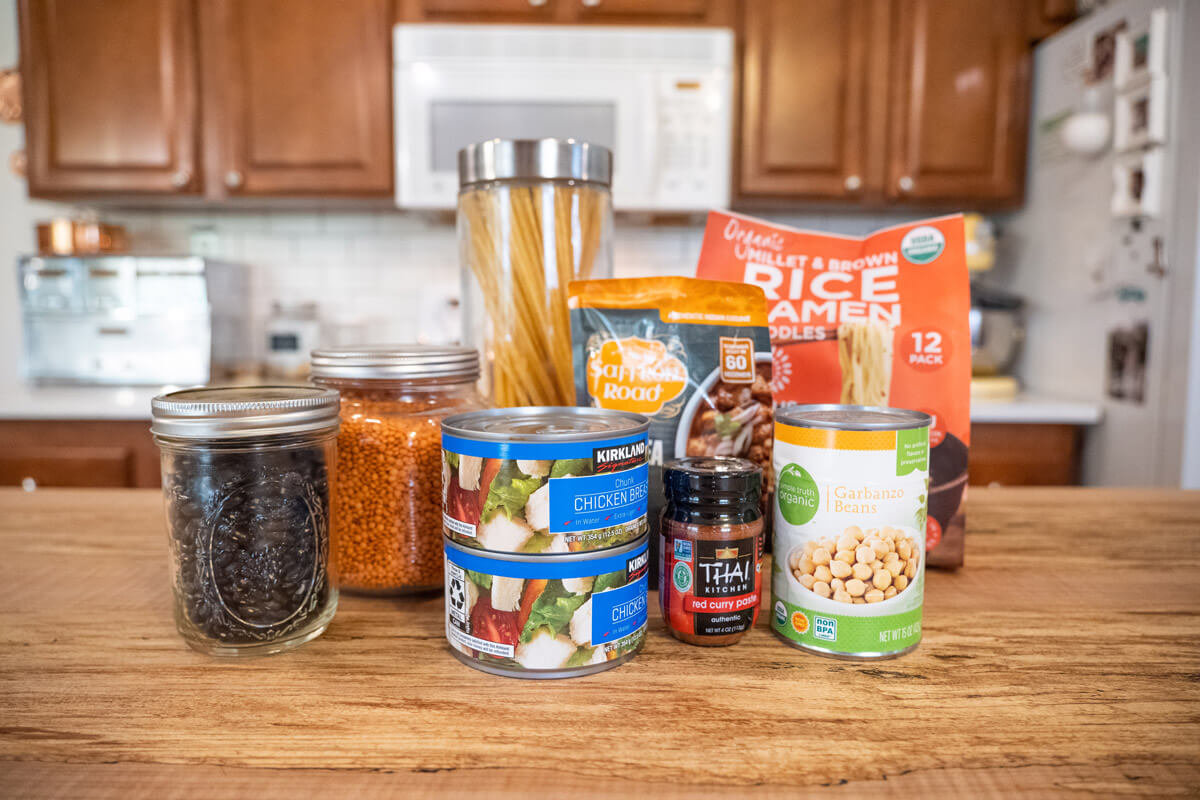You don’t need to be a “prepper” in order to have a well-stocked pantry filled with food that will feed you and your family long-term. There are some basics that I recommend always having on hand, and I’m sharing the items to stock up on that will store well on the shelf for 10+ years.

After talking to you about what I planned to do to increase my food production self-sufficiency I thought it would only be fair to talk to you about the stuff that I can’t produce myself but make sure I have on hand at all times.
What I’m sharing are items that we eat regularly and that we like to have a surplus of for long-term food storage.
I realize the way that we live as modern homesteaders and those that live very rurally are different from that of a lot of other people. I grew up in a home where my dad lived through the aftermath of The Great Depression, so these were skills passed down to me from that generation.
The Pioneering Today Podcast attached to this post (episode #253 13 Pantry Items to Always Have on Hand) is an older episode that I’ve since added to. And you can see a previous video on the 15 pantry items to stock up on from a couple of years ago further down in this blog post.
If that weren’t enough, we’ve recently added a new pantry area to our house and I’m giving you the full tour, plus some tips for how I store food long-term to help them last as long as possible.
Between the two videos, the podcast and the blog post, I’m certain you’ll find some helpful information on building up your own food storage supply. If you do run out of something, head over to this post, 37 Ingredient Substitutions Everyone Should Know!

Table of Contents[Hide][Show]
Azure Standard
The video in this post and the blog post are sponsored by Azure Standard. If you’ve been around here for long, you’ve probably heard me rave about Azure. I’ve been shopping through their website for over three years now.
Azure Standard is a family-owned and independent company dedicated to providing carefully chosen, affordable organic, natural and non-GMO groceries, health, household and garden products. In fact, they have over 12,000 options to meet the needs of health-minded households.
Along with regular-size orders, they also offer bulk orders, so that you can save even more on your monthly groceries.
This is what makes them the perfect sponsor for this video and blog post. Not only that, but for first-time Azure Standard customers, you can save 10% on your first order of $50 or more by using coupon code Pioneering10.
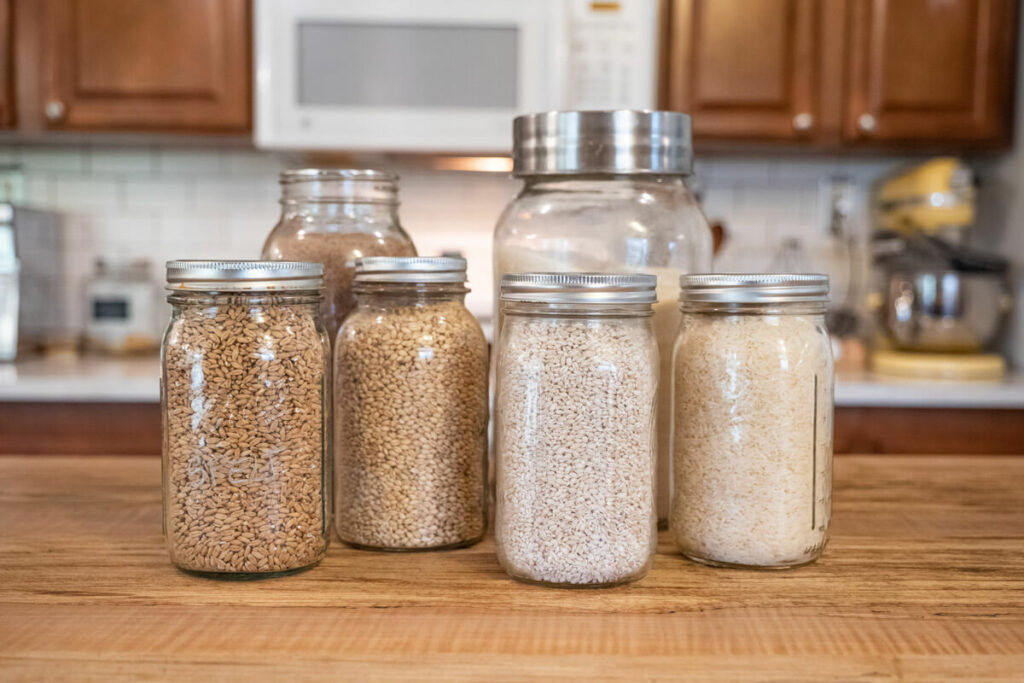
Must-Have Pantry Items
Flour, Wheat Berries & Grains
One of the most versatile pantry items is flour. Flour can be used as the base for so many homemade foods. By adding just a few ingredients into a bowl you can have incredible easy no-knead artisan bread.
The type of flour you’ll want to stock may vary from what I stock. For some, it might be a gluten-free blend. For others, it’s going to be just regular all-purpose. You can check out this post on how and where to buy grains in bulk as I discuss the various grains and their purposes in further detail.
I like to stock both whole grains and wheat berries for fresh milling, as well as all-purpose organic flour.
- Flour: I typically keep at least 50 pounds of flour on hand. I store it in two 5-gallon buckets with gamma-seal lids. Then, I have a smaller canister in my kitchen that I’ll refill from these buckets.
- Wheat Berries: I am trying to keep my supply between 50-100 lbs. You can read more about which grains are best for baking and cooking, and how to grind flour here.
- Spelt: I keep a minimum of 25 pounds of spelt grains on hand. Spelt is what I use more as my fresh ground pastry flour.
- Einkorn: I also have about 15 pounds of einkorn, an ancient grain, on hand. I kind of use it as pastry flour but it’s its own thing. The way you alter recipes and the way you cook with einkorn is different even from using spelt. I have a dedicated Baking Guide specifically for Einkorn in case you’d like to learn more.
- Hard White Wheat: I’m now keeping 75 pounds of hard white wheat on hand.
I don’t buy all of these from the same source. I’ve shared my favorite places of where to buy grains in bulk here. When you’re first starting out it can be hard to know the best places to find these types of things.
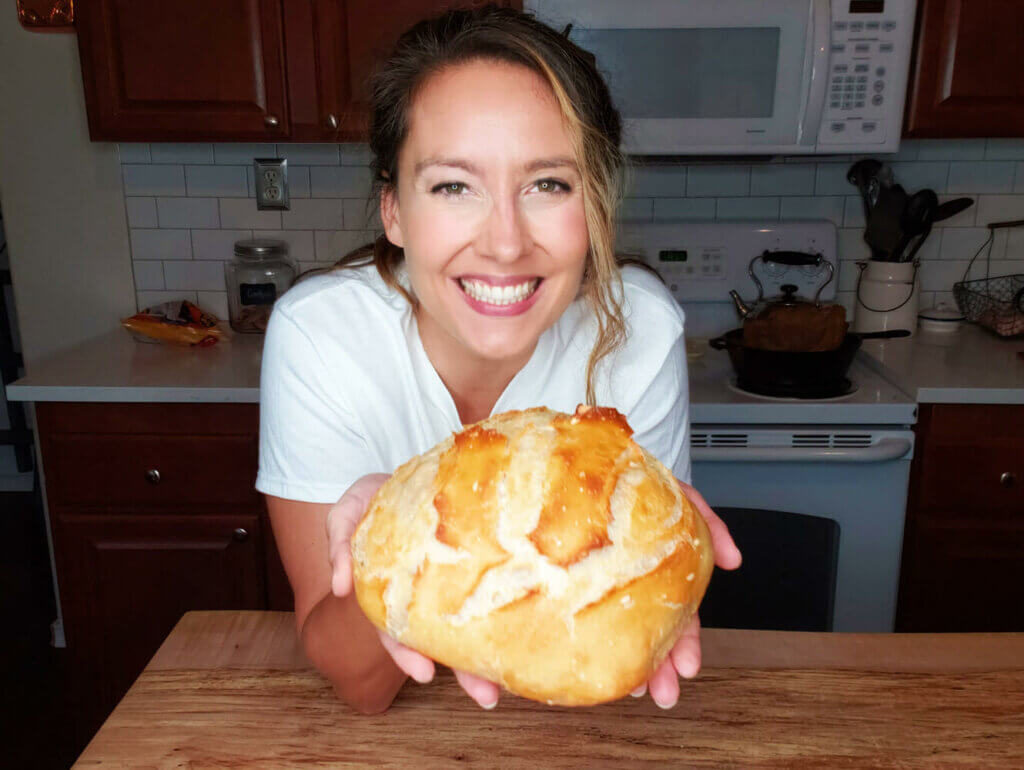
Yeast
For a while, many people were finding that yeast was difficult to find in the stores. This is why many people turned to making sourdough during the pandemic.
I already had yeast because I buy it in a large bulk bag from Costco. I store it in the refrigerator (or freezer) so it extends its shelf life.
Yeast will eventually expire and then it just doesn’t do its job. So knowing how to make your own yeast by culturing a sourdough starter (with just flour and water) is really the best-case scenario.
If you would like to dive deeper into sourdough, check out my free series, Homemade Sourdough. I’ll walk you through every step of creating a sourdough starter, including gluten-free, ancient grains, fresh ground flour, or just regular flour from the store.
Then, once you have a starter, you can enjoy sourdough sandwich bread or this incredible sourdough chocolate bread.
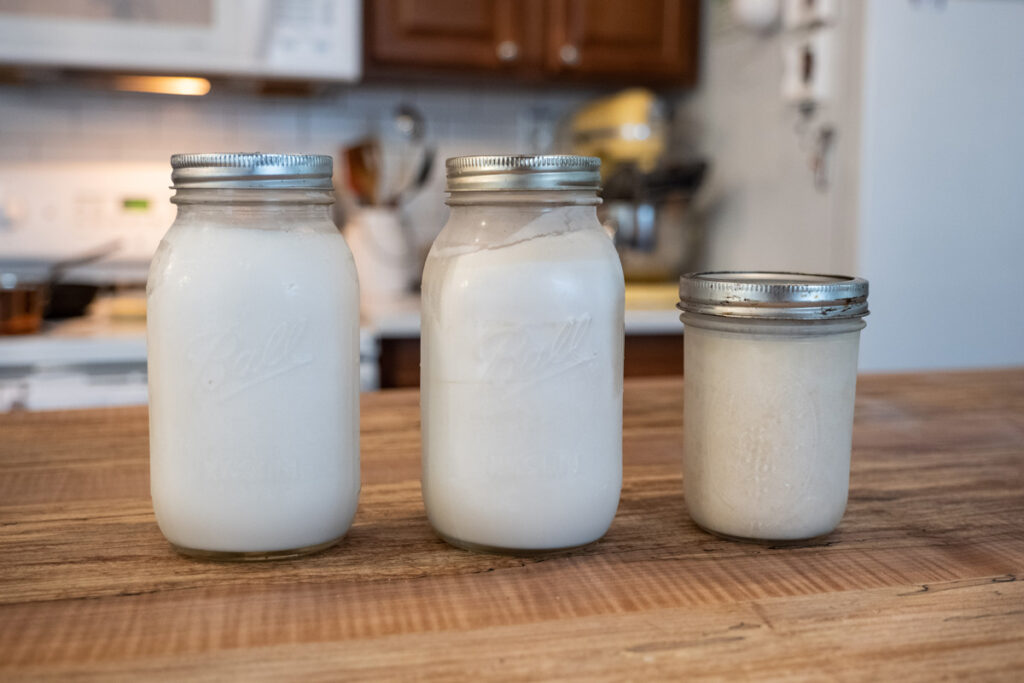
Fat Source
You’ll want to have some things that are shelf-stable and don’t require refrigeration, but I just can’t give up my butter. So I stock up on it and store it in the freezer.
Butter stores wonderfully in the freezer for a pretty long period of time. I’m sure I’ve had some butter in there for at least six months, if not longer. That’s one item that I do use my freezer for because you cannot can butter at home. It’s not safe to do so. Don’t do it.
Oils like coconut, avocado, and olive are all oils I like to keep on hand as well. In fact, I like to step up my cooking to the next level with homemade garlic infused olive oil.
I love buying my coconut oil from Azure Standard because it comes in a half-gallon glass jar that’s perfect for food storage once I’ve used up the coconut oil.
Aside from tallow and lard from when we butcher once a year, fat sources aren’t something that is easy to get or grow at home. So I highly recommend having back-ups of everything.
You can learn to render your own lard or tallow here.
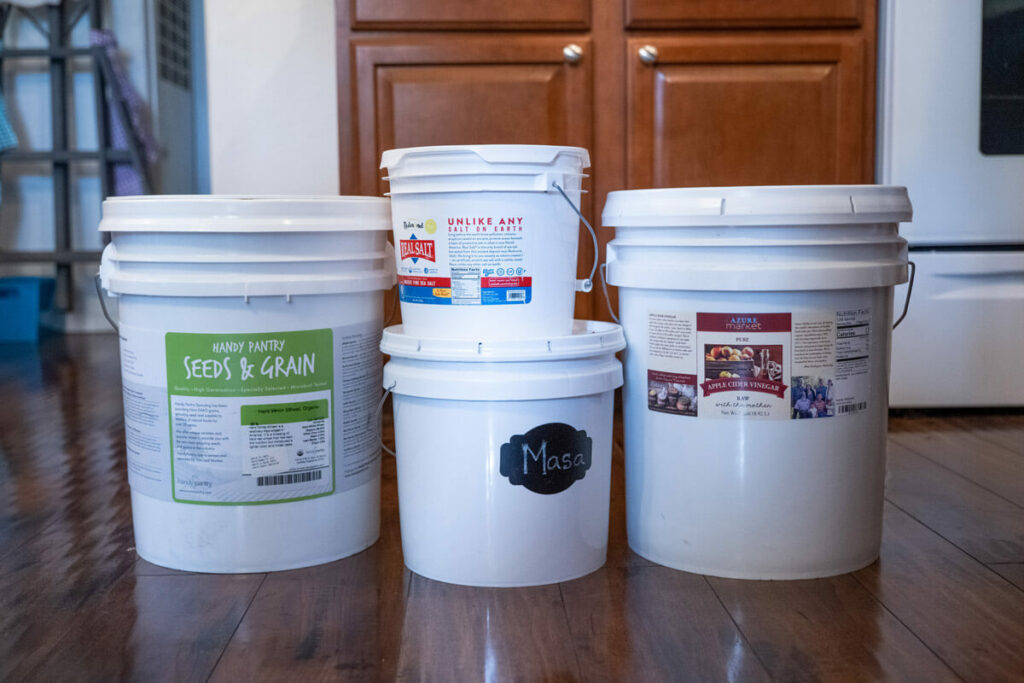
Salt
I purchase Redmond Sea Salt (use code “Pioneering” for 15% off at checkout) in a ten-pound bucket. Salt isn’t something that I can produce on my homestead and there isn’t a source to get it locally.
I use salt daily for seasoning. I also use salt for preserving such as in my ferments, canned pickles or refrigerator pickles, pickled asparagus, as well as preserving fresh basil (and Redmond’s is perfectly fine for canning, fermenting, and as our table salt!).
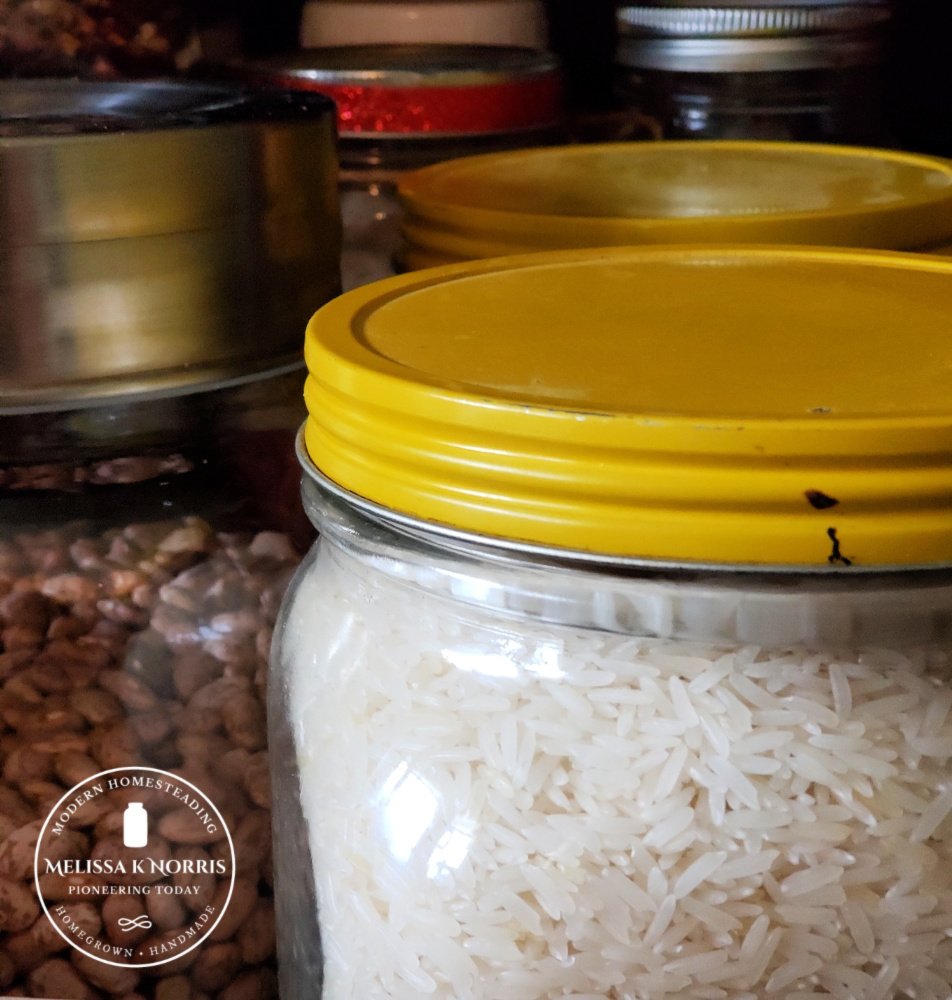
Dried Beans, Peas, Rice
Having dried beans, peas, and rice on hand is a great way to fill in a meal. These may not be the best for long-term storage, as anyone who has tried to cook beans after about the three-year mark knows that it’s hard to get them soft, no matter how long you cook them.
Canned beans are a different story as they’ll last on the shelf much longer. So if you’re buying dry beans in bulk, be sure to pressure can them up before they get too old. Learn how to pressure can here in my free video series.
For long-term food storage, it’s best to buy white rice. It will store for many more years than brown rice. When stored correctly, rice can sit for up to 20 years on the pantry shelf.
But from the outset, I didn’t have very much. I’ve since stocked up on my dried beans as well as lentils and split peas. All of them can be turned into soups, for the main dish, a side dish, or use to stretch out some different cuts of meat and vegetables. Because of this versatility, I felt it was important to get restocked on them.
Pasta
Pasta is another great way to stretch a meal. A bowl of pasta tossed with some butter alongside a protein can make a complete meal and fill hungry bellies.
Dried pasta will last for a couple of years on the pantry shelf, so keep rotating and continually re-stocking and you’ll be good to go.
Pasta is fantastic tossed with sauce, chilled and used in a cold salad, added to soups or casseroles. It’s extremely versatile.
Convenience Items
It’s really handy to have some pre-packaged convenience meals on hand that are easy to “heat and eat”. But just be sure it’s something your family actually enjoys!
Ideally, if you can find freeze-dried pre-packaged meals these will last the longest on your shelf. But if you’re buying items your family enjoys, just be sure you’re practicing proper rotation of the food where you’re eating the oldest food first (or FIFO: First In, First Out).

Condiments
For my most used condiments, I like to be sure I have at least two or three of each item on hand. This includes things like soy sauce (I like organic from Azure Standard), curry paste, mustard, ketchup, red pepper jelly, etc. I usually make homemade mayo in small batches as needed.
Protein
Though we raise all our own meat for the year, it’s still a good idea to have some ready-to-eat protein on the pantry shelf. This is especially important if you’re not currently raising your own meat.
Consider canned chicken, canned beef, canned tuna, and even canned salmon to stock your pantry.
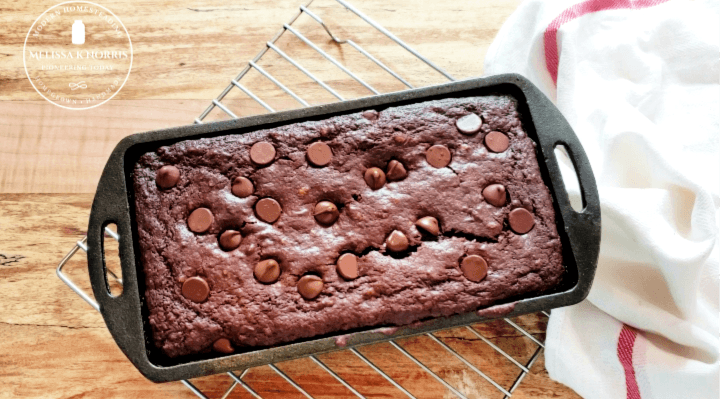
Chocolate
We love chocolate so I need to make sure that we have it in a couple of forms.
- Cocoa Powder: I usually buy it in a 10-pound bag from Azure.
- Chocolate Chips: I only buy organic chocolate chips because of the soy that’s found in a lot of other chocolate chips. If we’re going to consume soy, I want to make sure it’s organic and non-GMO certified. I used to get my chocolate chips from Fred Meyer, until I found them through Azure Standard for a better price.
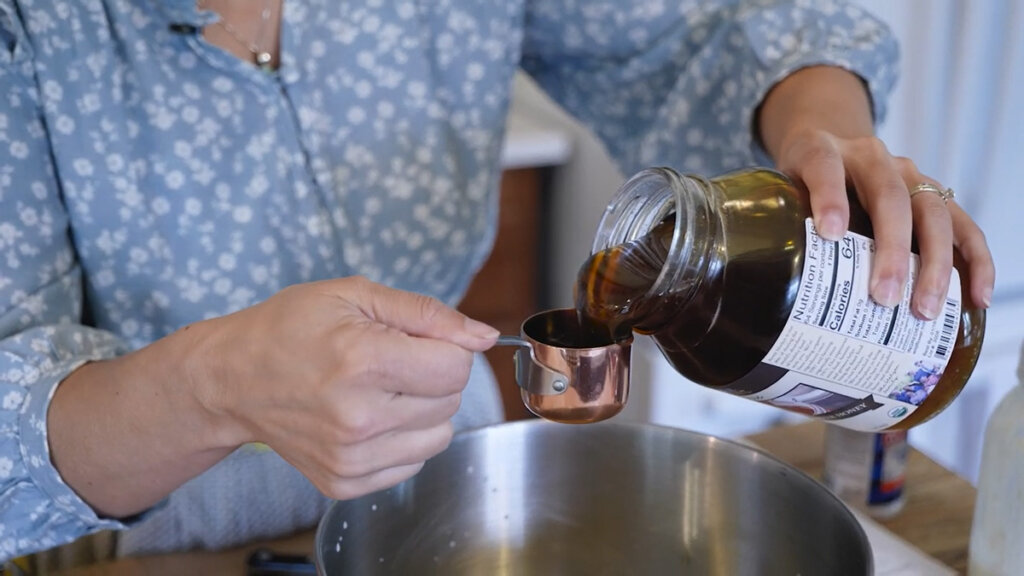
Sweetener
I know, we don’t love that we eat sugar. But it is something that I use in my regular baking when I’m not doing Keto. I’ll list the supplies I keep on hand for a Keto diet below.
- Sugar: Sugar is easy to store long-term and is good to have for baking and canning. I usually keep about 30 pounds of sugar stocked so I’ll have enough to do all my fruit preserving.
- Honey: Honey will store indefinitely on the pantry shelf. It will crystalize and become solid, but all you have to do is gently heat it back up and it will become liquid again. If you have raw honey, be sure not to heat it up too high or you’ll destroy the beneficial enzymes (don’t use a microwave, simply place it in a pot of warm water on the stove and gently warm it until it liquefies).
- Keto sugar alternatives: For keto-friendly sweeteners, I like to keep a good supply of Monk Fruit, Stevia, and Erythritol.
Baking Powder & Baking Soda
In baking, you need a leavening agent. Not all recipes need it, such as sourdough bread, but other items like pancakes and waffles do. In those I’m either going to be using baking soda or baking powder, sometimes both depending upon the recipe so I want to make sure I’m well stocked on them.
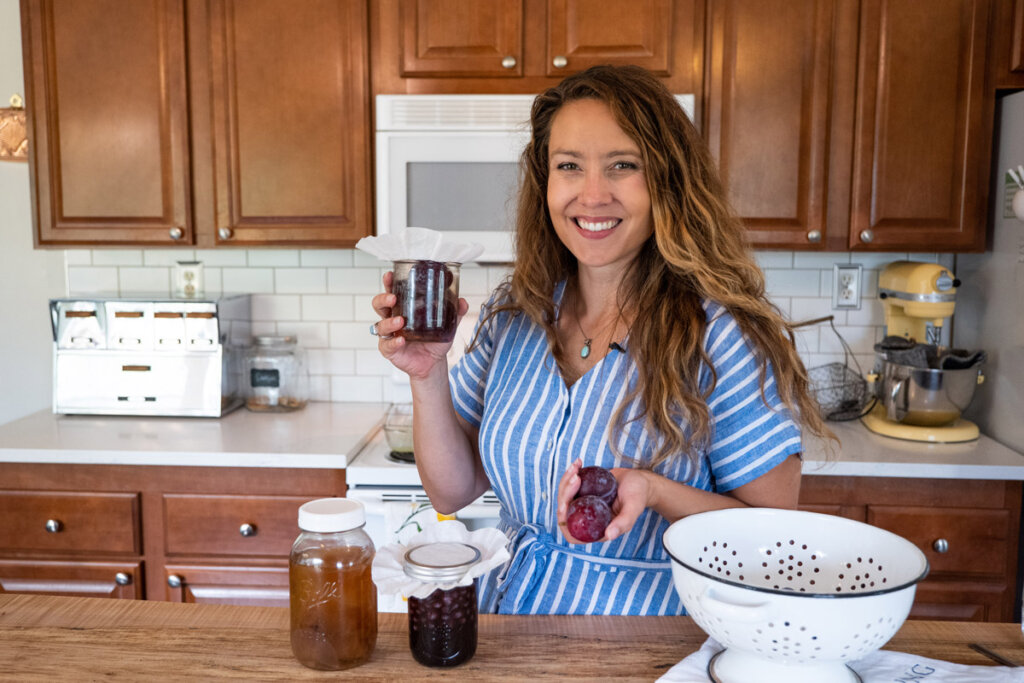
Apple Cider Vinegar
I make sure to stock up on store-bought apple cider vinegar (ACV) even though I make my own apple cider vinegar and other fruit vinegars at home.
The reason is that when canning the vinegar has to be 5% acidity in order to make sure that your canning recipes are safe, especially your pickling recipes. So I keep extra on hand to ensure I can get through the canning season. I buy it in a 5-gallon bucket from Azure.
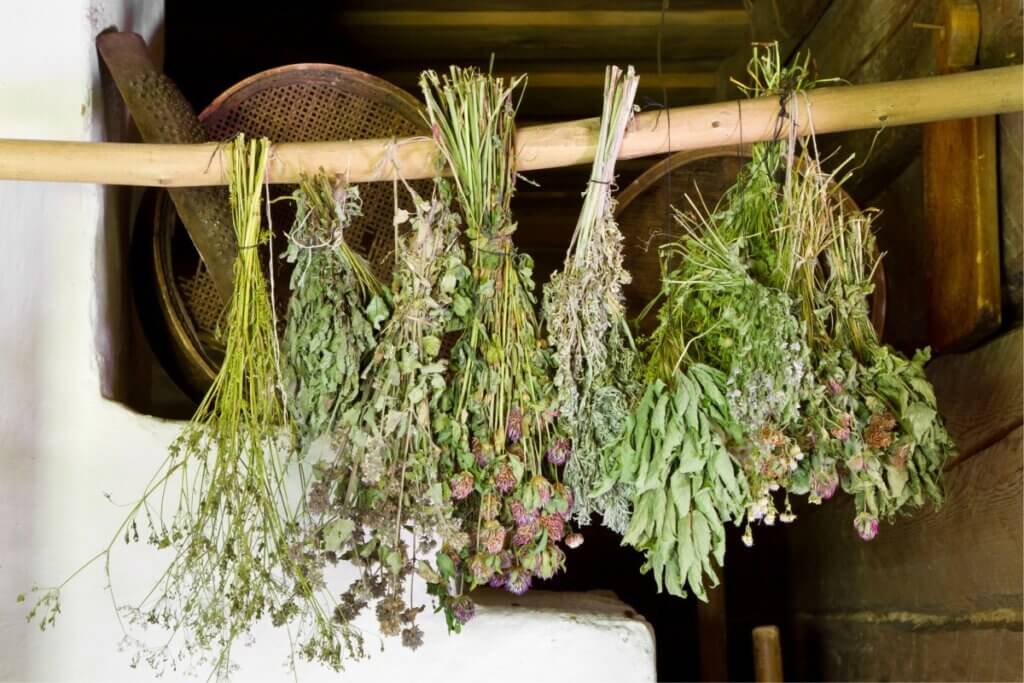
Herbs
I grow most of our herbs myself. If you don’t grow them yourself, you can order in bulk from Azure Standard. The herbs I grow are:
- Rosemary
- Sage
- Mint
- Chive
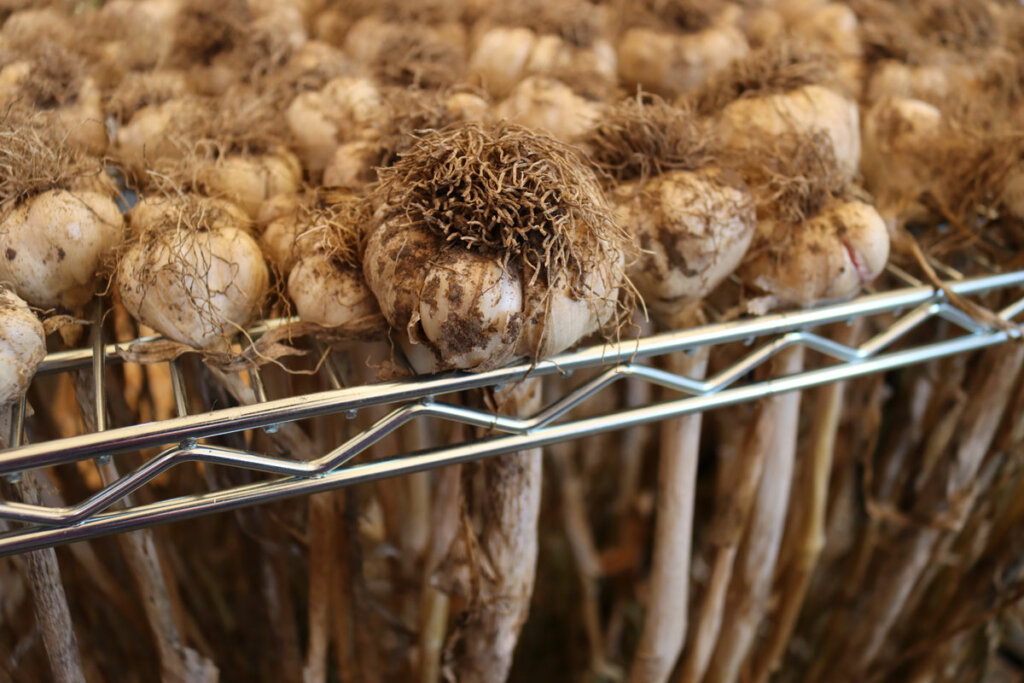
Aromatics
- Garlic
- Onion
Garlic and onions are aromatics I like to grow a year’s worth of in my garden. I’m also working on seed saving to have a closed-loop system for food security.
I probably use garlic and onion on a daily basis in my home, so I consider them essential. If you’re worried about the shelf stability of fresh onion and garlic, dehydrated onion and garlic are a great option.
If you’re interested in growing both you’ll want to choose a good storage variety. Check out this post on growing onions and this post on growing garlic for more information and good storage varieties.
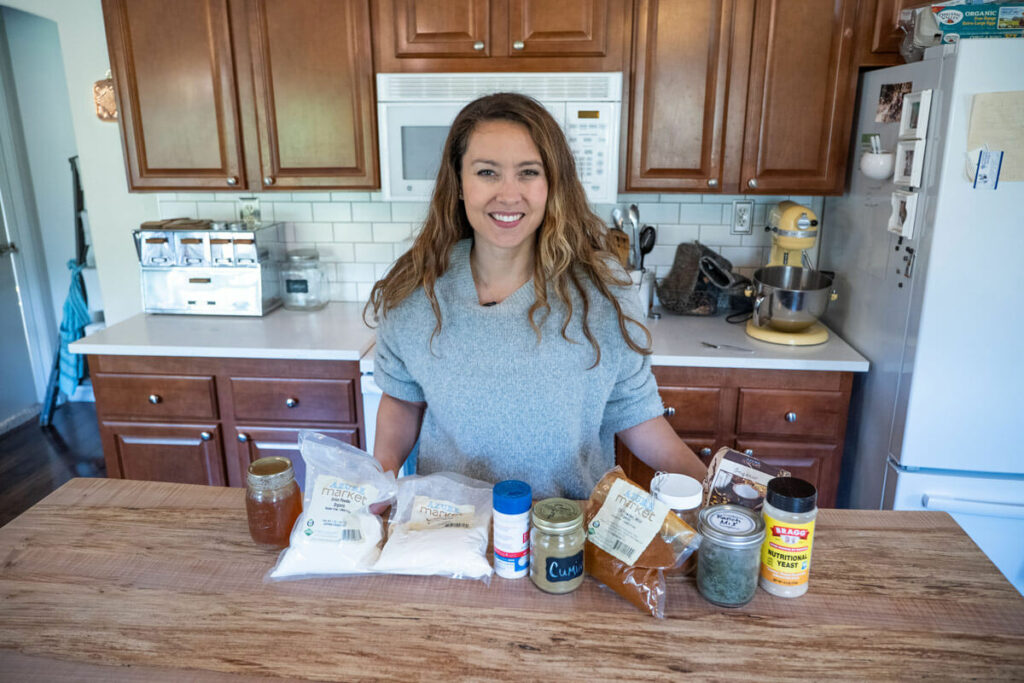
Spices
While you can grow some different varieties of chili peppers to make your own spices, I don’t because our weather is not always conducive to growing hot peppers. I may experiment with this in the future. In the meantime, I make sure to have the following on hand:
- Chili Powder
- Cumin
- Paprika
- Tumeric
- Curry Powder
For the majority of those spices, I like to store a pound. What I do is take a pint-size jar (which holds 2 cups worth) and keep it in my spice cabinet. Then I like to have a backup bag to refill. When the bag gets low, I’ll reorder to keep my stock up.
You’re noticing a trend here, right? I like to have what I’m using. I like that amount to be full and then I like to have a backup in the back pantry in order to refill my kitchen stock without having to go to the store right away.
Dairy
Dairy is one item that’s hard to store long-term. Most of the fresh dairy products will need to be purchased (Azure has a great variety).
I also like to make freeze-dried milk powder (or you can buy it from Azure, they offer an A2/A2 variety). This is what we use to make our homemade cocoa mix.
Butter and most cheeses also freeze well.
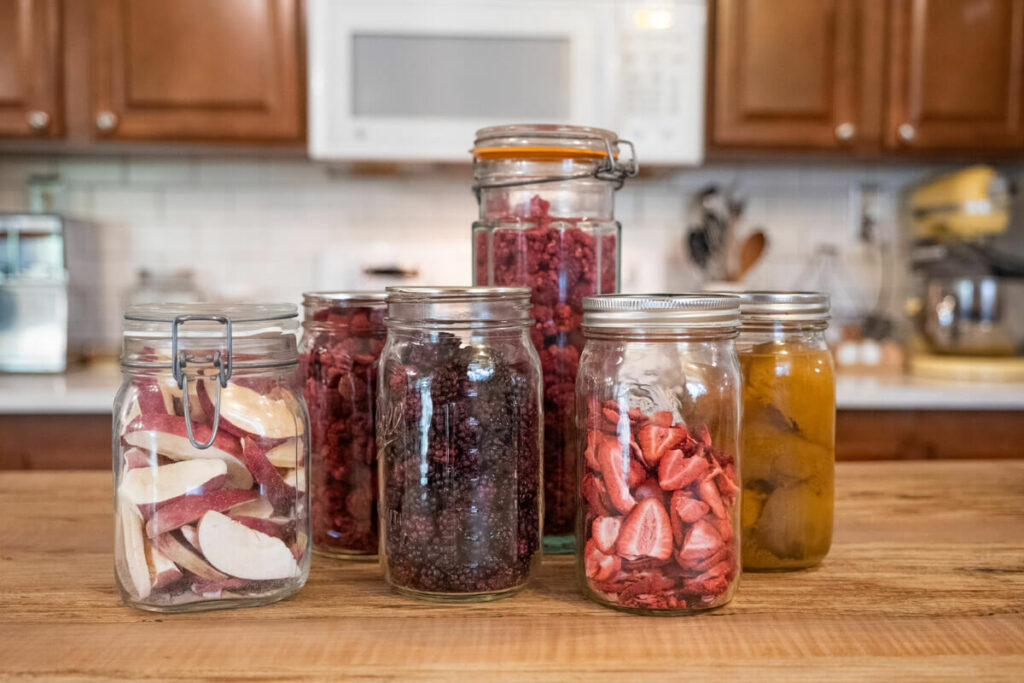
Fruit
Canned fruit, whether it’s home-canned or store-bought, will last on the shelf for a very long time. Learn how to can pears here, I include an easy old farmer’s wife trick to peel them.
Freeze-dried fruit will last even longer than those canned items. If you don’t have a freeze dryer, you can check out the home freeze-dryer options from Harvest Right here.
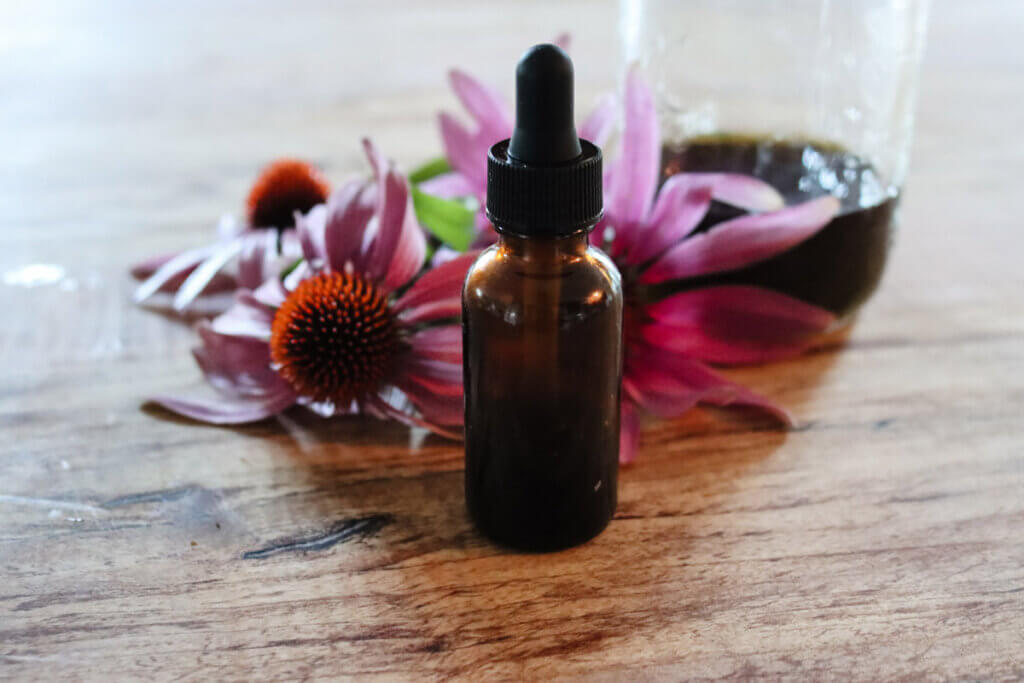
Alcohol, Tinctures & Extracts
Though it’s not really food, I do like to keep alcohol on hand so I can make my homemade tinctures and extracts.
These will last indefinitely on the pantry shelf, and they are something that will tend to get better with time!
There you have it! Though this isn’t a complete list, I hope this gives you some inspiration to start stocking your pantry, even if it’s just little by little, so you’re well prepared.
If the last few years have taught us anything, it’s that preparation is never a bad thing.
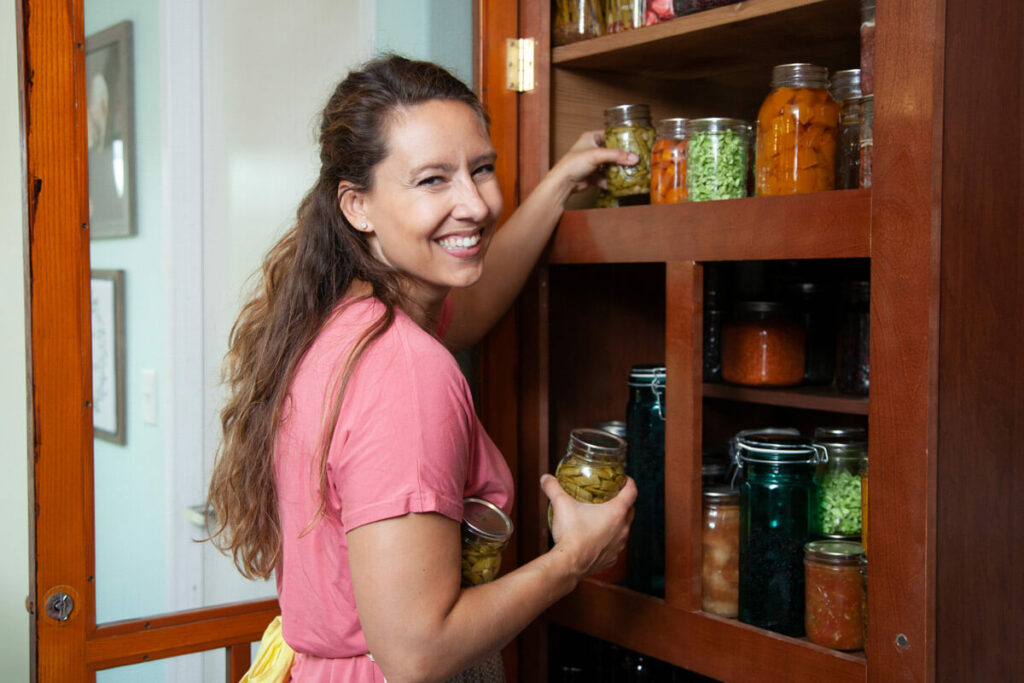
More Articles You May Enjoy
- Keeping a Well-Stocked Pantry for Quick & Easy Dinners
- DIY Pantry Mixes
- Freeze Drying vs. Dehydrating Food (Which is Best?)
- Building a Great Depression Era Pantry
- 9 Things To Do Now for Fall Preparations
- Natural Cheese Making with Robyn Jackson
- 7 Things We’ll Never Go Back to Since 2020
- Homestead Plan to Alleviate Fear & Be Prepared
- Toilet Paper Substitutes & Tips for Reusable Household Items
- Impact of Being in the Midst of a Crisis How Homesteading Helps
- COVID Remedies & Online Censorship
- Seventh-Year Land Sabbath and Bread Baking Tips (Live Coaching Call)
